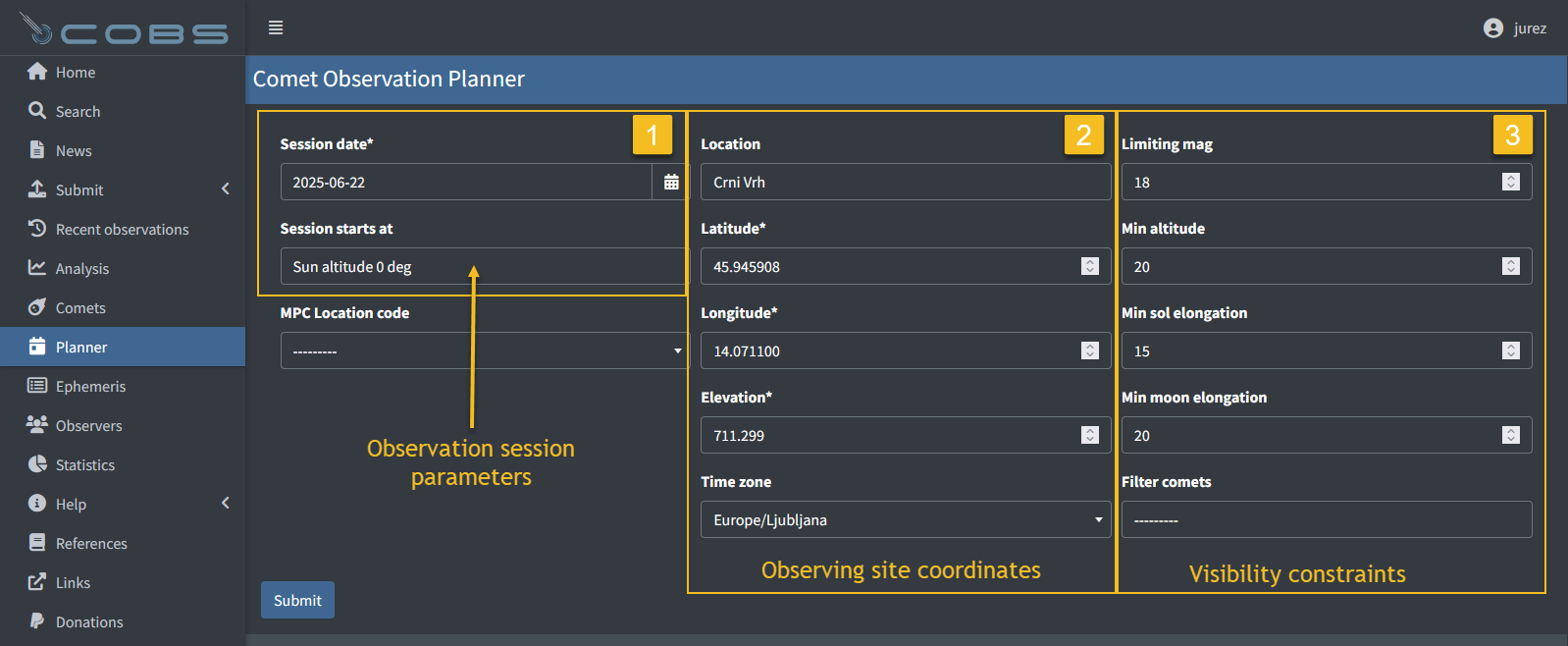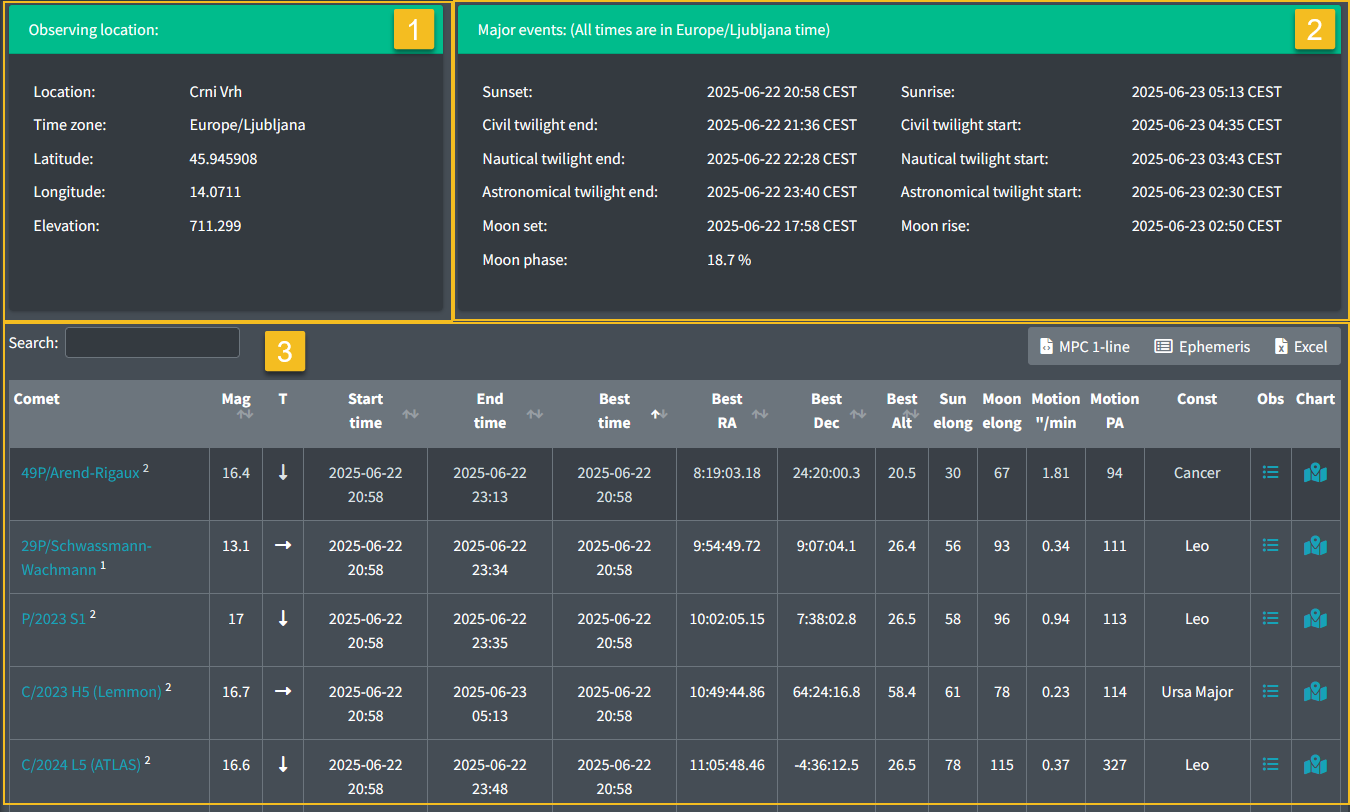How to Use Comet Observation Planner
What Is the Comet Observation Planner?
The Comet Observation Planner allows you to generate a list of observable comets for a specific date, time, and location. It filters comets based on visibility criteria such as altitude, brightness, and elongation, helping you choose the best targets for your observing session.
How to Use the Planner

1. Set Your Observation Parameters
Fill in the following fields:
- Session Date: Choose the date of your planned observation.
- Session Starts At: choose when your session begins based on the Sun's altitude:
- 0° – Sunset
- -6° – End of civil twilight
- -12° – End of nautical twilight
- -15° – Deep twilight
- -18° – End of astronomical twilight (start of astronomical night)
2. Observing site coordinates:
You can either:
- Select a MPC Location Code (if you have a Minor Planet Center code), or
- Manually enter your Latitude and Longitude and Elevation (in meters).
- Time Zone: Choose your local time zone offset from UTC if you want the results displayed in local time.
3. Define Visibility Constraints
These filters help refine the list of observable comets:
- Limiting Magnitude: The faintest magnitude your equipment can detect.
- Minimum Altitude: The lowest altitude (in degrees) above the horizon for a comet to be considered observable.
- Minimum Solar Elongation: Minimum angular distance from the Sun.
- Minimum Moon Elongation: Minimum angular distance from the Moon.
- Filter Comets by Observation History
Click "Filter Comets" to narrow the list based on recent observation activity:- Observed in last 30 days
- Observed in last 1 year
- Observed
- Not observed
4. Submit Your Search
Once all parameters are set, click the "Submit" button to generate your personalized list of observable comets.
Understanding the Planner Output
After clicking Submit, the planner generates a detailed report divided into three main sections:

1. Observing Location Information
This section summarizes the parameters of your observing session, including:
- Observing site name
- Time Zone Offset from UTC
- Latitude and Longitude
- Elevation (in meters)
This information helps confirm that the planner is using the correct settings for your location and time.
2. Major Events
This section provides key astronomical events for your selected date and location, including:
- Sun Events:
- Sunset and Sunrise
- Civil Twilight (start and end)
- Nautical Twilight (start and end)
- Astronomical Twilight (start and end)
- Moon Events:
- Moonrise and Moonset
- Moon Phase (e.g., New Moon, First Quarter, Full Moon)
These events help you plan your session around optimal darkness and avoid interference from moonlight.
3. Observable Comets Table
This section lists all comets that meet your visibility criteria.
The table is:
- Searchable – Quickly find comets by name, constellation, or other parameters.
- Sortable – Click on column headers to sort by magnitude, right ascention, best time, altitude, etc.
- Exportable – You can export the full table to an Excel file for offline use or further analysis.
Each row in the table provides detailed information to help you evaluate and plan your observations:
- Comet Name: The official designation of the comet
- Predicted Magnitude: Estimated brightness at the time of observation
- Magnitude Trend: Whether the comet is brightening, fading, or stable
- Observation Window:
- Start Time and End Time when the comet is above the minimum altitude
- Best Observation Time
- Sky Coordinates at Best Time:
- Right Ascension (RA) and Declination (Dec)
- Altitude above Horizon (in degrees)
- Elongation:
- Angular distance from the Sun
- Angular distance from the Moon
- Apparent Sky Motion:
Speed and direction of the comet’s movement across the sky. - Constellation: The constellation in which the comet is located at the observation time.
- Quick Links:
- Observations: Direct link to the comet’s observation history on the COBS database.
- Finding Chart: Link to a sky chart for the comet’s position, provided by in-the-sky.org.
This table is your primary tool for selecting which comets to observe and when.
Tips for Better Planning
- Use a realistic limiting magnitude based on your telescope and sky conditions.
- Set a minimum altitude of 20° or more to avoid atmospheric distortion.
- Avoid comets too close to the Sun or Moon to reduce glare and improve visibility.
- Use the observation charts provided to locate comets in the sky.